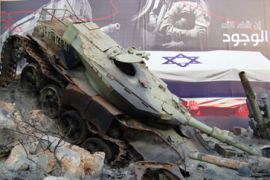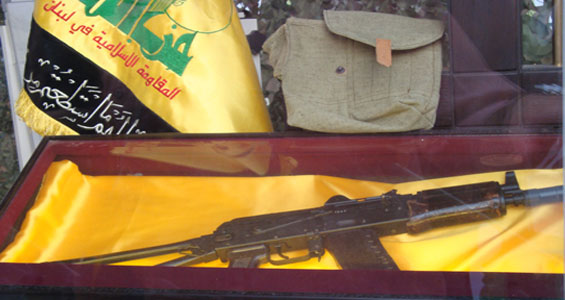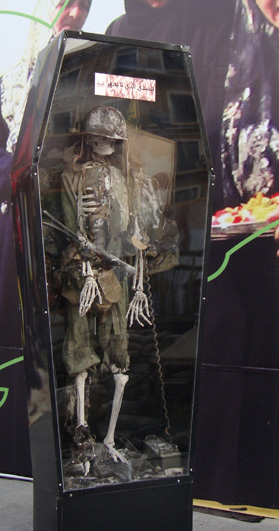Hezbollah exhibit hails ‘martyr’
Thousands of young Lebanese flock to the museum which honours Imad Moughniyah.

 |
| Moughniyah’s rifle on display with a Hezbollah flag reading “the Islamic resistance in Lebanon” in the background [SANDELS] |
In a large car park in Lebanon’s southern city of Nabatiyeh, schoolchildren are spending the first days of Ramadan examining the remains of a captured Israeli Merkava tank.
A plume of artificial smoke surrounds it every few minutes, mimicking battlefield explosions.
Surrounding the tank are the personal belongings of Imad Moughniyah, a Hezbollah military commander killed in a car bombing in Damascus in February.
Hezbollah blamed his death on an Israeli operation.
“These are the clothes he was wearing when he was murdered. There are still blood stains on them if you look closely. They have not been washed,” Ali Yasseen, the curator at the Al-Imad: The Leader of the Two Victories exhibit, tells a group of curious onlookers.
Once nicknamed ‘the Fox’ or ‘Abu-Dokhan’ (the smoke-bearer) by some for his ability to elude capture, Moughniyah was included on the most wanted lists in the United States and Israel for allegedly spearheading a series of attacks in the 1980s and 1990s, including the abduction of Western hostages in Lebanon and a plane hijacking.
“It personalises Hajj Imad (Moughniyah) and gives a pure picture of the destroyed (Israeli) army in South Lebanon. His strengths and abilities are shown in the different parts to the exhibition. It is an artistic way of showing how he defended our country,” Emad Awada, the manager of the exhibition, told Al Jazeera.
The exhibition, inaugurated in July, commemorates the two-year anniversary of the 2006 summer war with Israel and is a special tribute to the group’s military chief.
Crossing the ‘victory bridge’
 |
| A fake skeleton at the exhibit is a haunting reminder of the war [SANDELS] |
At the entrance of the exhibit, visitors are greeted by a row of Hezbollah’s green and yellow flags and a giant olive cap of the type worn by Moughniyah in battles. Visitors then cross the ‘victory bridge’ decorated with captured Israeli battle equipment and artillery shells painted in gold.
“This is called the ‘Square of the Defeat’,” says Yasseen, as loudspeakers carry revolutionary anthems intermixed with recorded gunfire.
Charred remains of Israeli tanks, artillery equipment, and scattered military boots, helmets and army badges line the route visitors take. A fake skeleton in Israeli army uniform glares out of its coffin at visitors.
It lies in the shadow of the remains of an Israeli helicopter that was shot down in 2006.
“Look at the letters engraved here. It says it is from the Israeli army,” continues the curator and points towards a piece of artillery with Hebrew letters written on it.
At the ‘Era of Victory’ exhibit, several glass monitors house the wills of the ‘martyred’ combatants and one monitor is filled with cameras and video taping equipment belonging to combat photographers who died in battle.
Next to a sprinkling fountain and inside a glass bunker lie the black pants, the brown leather shoes, raincoat, and chequered scarf Moughniyah wore when he was assassinated in Syria.
At the end of the exhibit, visitors are greeted by a well-stocked souvenir shop where Moughniyah memorabilia such as posters, caps, and key rings are available for purchase.
The crowds
Whether it is viewed as a symbolic venue or a kitschy war-like theme park to others, the exhibit has managed to attract the crowds.
Awada says that between 10,000 to 15,000 people visits the exhibition every day.
“On the first day of Ramadan alone we had 25,000 visitors,” he added.
One of them is 19-year-old Esra’a who said she wanted to visit the exhibition to learn more about Moughniyah’s role in “defending her country”.
“I came here to see what has happened. To see what Israel has done to my country. Martyr Imad Moughniyah has taught us many beautiful things. He is the right person. He has led us to live in freedom,” she told Al Jazeera.
Dani El-Ali, a Lebanese woman living in Saudi Arabia, toured the exhibition with her three children.
“I never knew much about Moughniyah, but when he died I realised how important he was. He is the leader who protected my land and made me come back to it,” she said
House of the spider
In the summer of 2007, Hezbollah hosted the commemorative museum exhibit of the 2006 war; ‘The House of the Spider’ (Beit Al-Ankabut) exhibit was held in the south Beirut district of Dahiye, one of the hardest-hit during the conflict.
A year later, the same team of architects and engineers behind ‘The Spider’s House’ came together for the ‘Al-Imad’ exposition.
“A team of 290 people worked on the project. We planned it all in one day only and it took 20 days to put the exhibit together. They worked from early morning to late night. This time required more preparations and more work,” Awada said.
“We use this exhibition as a portrayal of the victory to the rest of the world.”